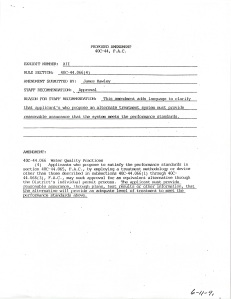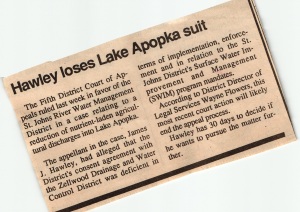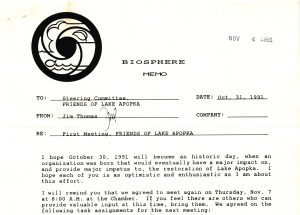I mentioned last week the publishing by the St Johns Water Management District, in 1994, of a waste load allocation rule that would limit what the Apopka farms could discharge.
The Zellwood Drainage District challenged this rule on various grounds. The fifteen-page petition is in the FOLA archives. The District disputed various aspects of the rule. One charge is that the SJRWMD exceeded its authority in declaring the Lake a “work of the district”, as the lake is not itself a “work”, and bottom of the lake is owned by the Trustees of the Internal Improvement Fund. (Did I mention the Trustees already? The archives also contain a document giving the history of this fund. In summary, the Trustees Fund was formed to invest in improvements to Florida infrastructure when Florida became a state. The fund handled railroads, bridges, etc., but also, because of its role in drainage projects, was given control of vast amounts of submerged land in the state.)
The other claims involve sections of the rule as being “arbitrary and capricious”, as well as questioning whether, in setting a water quality standard, the SJRWMD exceeded its authority.The scientific reasoning behind the rule was also disputed.
The DUDA farms, also on the north shore, but west of the Zellwood District, initially challenged the waste load rule as well. However, after discussion with the WMD, they voluntarily constructed holding ponds for their waste water, as well as a pipeline that would take their discharge and disperse over land that would help it naturally filter out the phosphorus. After this, they voluntarily dropped their challenge.
FOLA filed to intervene in the petition. Unfortunately, in August 1995, the challenge was upheld, and the rule deemed invalid, as it was agreed the SJRWMD had exceeded its authority in setting water quality standards.
This wasn’t the only thing going on in 1995. Other restoration work included the harvesting of gizzard shad from the lake, continuation of planting aquatic vegetation in the lake’s littoral zone, and studies of alum treatment as a way to reduce phosphorus in the lake. But projects like this would be meaningless if the phosphorus discharge could not be stopped.
One method was something called “upland disposal”. This was another pet project of FOLA’s, and involved disposing of farm discharge into different types of basin that would remove the phosphorus from the discharge. This project received support from Linda Chapin, Orange County Chairman.
So that’s 1995, mostly. Next year will see things really heat up, as the farms decide a buyout is the only way they can “reduce” their phosphorus discharge.



